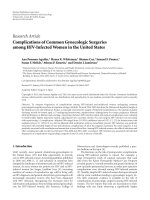An examination of municipal finance reform regarding municipal bankruptcies in the United States
Bạn đang xem bản rút gọn của tài liệu. Xem và tải ngay bản đầy đủ của tài liệu tại đây (865.26 KB, 341 trang )
AN EXAMINATION OF MUNICIPAL FINANCE REFORM REGARDING
MUNICIPAL BANKRUPTCIES IN THE UNITED STATES
Except where reference is made to the work of others, the work described in this
dissertation is my own or was done in collaboration with my advisory committee. This
dissertation does not include proprietary or classified information.
_____________________________
Keren H. Deal
Certificate of Approval:
_____________________________ _____________________________
Bradley Moody Cynthia J. Bowling, Chair
Associate Professor Associate Professor
Political Science and Political Science
Public Administration
_____________________________ _____________________________
Kalu Kalu Anne Permaloff
Associate Professor Professor
Political Science and Political Science and
Public Administration Public Administration
_____________________________
Joe F. Pittman
Interim Dean
Graduate School
AN EXAMINATION OF MUNICIPAL FINANCE REFORM REGARDING
MUNICIPAL BANKRUPTCIES IN THE UNITED STATES
Keren H. Deal
A Dissertation
Submitted to
the Graduate Faculty of
Auburn University
in Partial Fulfillment of the
Requirements for the
Degree of
Doctor of Philosophy
Auburn, Alabama
August 4, 2007
UMI Number: 3273352
3273352
2007
Copyright 2007 by
Deal, Keren H.
UMI Microform
Copyright
All rights reserved. This microform edition is protected against
unauthorized copying under Title 17, United States Code.
ProQuest Information and Learning Company
300 North Zeeb Road
P.O. Box 1346
Ann Arbor, MI 48106-1346
All rights reserved.
by ProQuest Information and Learning Company.
AN EXAMINATION OF MUNICIPAL FINANCE REFORM REGARDING
MUNICIPAL BANKRUPTCIES IN THE UNITED STATES
Keren H. Deal
Permission is granted to Auburn University to make copies of this dissertation at its
discretion, upon request of individuals or institutions and at their expense. The author
reserves all publication rights.
__________________________________
Signature of Author
__________________________________
Date of Graduation
iii
VITA
Keren H. Deal, daughter of Richard and Phyllis Hill, Sr., was born September 16,
1967 in Montgomery, Alabama. She graduated with her B.S. in Accounting from
Auburn University Montgomery in 1992 and received her M.B.A. in Business
Administration from Auburn University Montgomery, with an emphasis in accounting, in
1995. She received her C.P.A. in 1999. She worked for the State of Alabama in various
classifications, including Accountant I, II, and III from 1985 to 2000. In August 2000,
she accepted an Instructor of Accounting position in the Auburn University Montgomery
Accounting and Finance Department. In 2002, she married John H. Deal, Jr. and was
blessed with the birth of their son, Zachary, in November, 2002. In 2005, she entered the
doctoral program in Public Administration and Public Policy at Auburn University. In
2007, she received her doctoral degree in Public Administration with an emphasis in
Public Finance and Governmental Accounting. In June 2007, she returned to Auburn
University Montgomery as an Assistant Professor in Accounting.
iv
DISSERTATION ABSTRACT
AN EXAMINATION OF MUNICIPAL FINANCE REFORM REGARDING
MUNICIPAL BANKRUPTCIES IN THE UNITED STATES
Keren H. Deal
Doctor of Philosophy, August 4, 2007
(M.B.A., Auburn University Montgomery, 1995)
(B.S., Auburn University Montgomery, 1992)
339 typed pages
Directed by Cynthia Bowling
Municipal bankruptcy is considered rare. A total of 569 U.S. municipalities filed
Chapter 9 from 1938-2005; however, the occurrence of Chapter 9 cases since 1990 seems
to be escalating nationwide. At the time of this writing, 29 states allow their
municipalities to file for Chapter 9 protection. Of these 29 states, 14 states do not require
an additional step to be taken by the municipality prior to filing bankruptcy documents,
such as approval by the Governor or state agency or commission. Alabama’s current
legislation allows municipalities to file for Chapter 9 protection without notification of
the state government.
Alabama is ranked fourth in all municipal bankruptcy filings that occurred
between 1990 and 2004. However, when considering the total state municipal
v
bankruptcy filings per number of local governments per state, Alabama is ranked first in
the total filings per number of local governments during the 1990 to 2004 period.
In light of the increase in filings, an analysis of the nine Alabama municipal
bankruptcies was conducted. The overall contributing factors found were a mixture of
financial mismanagement by public officials and the economic decline of the
municipalities from loss of businesses and demographic changes. The total financial
impact of these municipal bankruptcies is unknown; however, an analysis of the interest
rates of debt issuances from two of the municipalities that underwent bankruptcy showed
that both municipalities incurred higher-than-average interest rates. This translates to a
higher burden on the local taxpayer to repay the debt.
This study also performed a comparative analysis on the financial reform methods
enacted by Florida, Georgia, North Carolina, Ohio, Pennsylvania, and Tennessee in
dealing with local government fiscal stress and municipal bankruptcy. A secondary
analysis of the policies and procedures currently employed by the Alabama State
Department of Education (SDE) for local boards of education in Alabama was also
conducted.
Bankruptcy, of any type, should be considered as a last resort. Numerous
municipal bankruptcies indicate underlying state policy problems in addressing local
government finances. This study found information that might be useful to elected
officials in Alabama and public administrators in considering other state programs as well
as the SDE for municipal finance reform and in determining future policies for local
governments in Alabama.
vi
ACKNOWLEDGEMENTS
The author would like to express thanks and gratitude to those who were
instrumental in development of this research study and the completion of the doctoral
program. I am especially indebted to Dr. Carl Grafton, Dr. Cynthia Bowling, Dr. Anne
Permaloff, Dr. Brad Moody, and Dr. Kalu Kalu in this research endeavor. All of these
professors provided invaluable insight and guidance during the phases of the research as
well as encouraged and assisted me in the finalization of this research product. This
research is a testament to their dedication and support of the students in the doctoral
program. Also, gratitude goes to those public officials and academia that assisted me in
this research and were most forthcoming with their knowledge.
God has blessed me with His love along with a loving support system of family,
friends, and colleagues too numerous to name individually in this one page. Thank you
all for your love and support. A special thank you goes to Joe Davis and Judy Kamnikar
for their willingness to always help me and keep me sane.
None of this would have been possible without the help of my family. My
husband and son, Chip and Zachary, along with my parents and niece, Richard, Phyllis,
and Kaitlyn Hill, have supported me without fail. All of you have endured the highs and
lows with me throughout this entire process. Your unwavering love, patience, and
understanding have made this possible. This degree is as much yours as it is mine and I
will be eternally grateful for your support.
vii
Style Manual Used: Publication Manual of the American Psychological Association
(2001)
Computer Software Used: Microsoft Word and Excel
viii
TABLE OF CONTENTS
PAGE
LIST OF TABLES xiv
LIST OF FIGURES xvii
CHAPTER
I AN EXAMINATION OF MUNICIPAL FINANCE
REFORM REGARDING MUNICIPAL BANKRUPTCIES
IN THE UNITED STATES 1
Introduction 1
Statement of Problem 5
Research Questions 18
Purpose and Significance of the Research Questions 18
Methodology 19
Overview of Chapters 21
II LITERATURE REVIEW 23
Introduction to Fiscal Stress 24
Studies on Fiscal Stress 32
Municipal Bankruptcy 51
State Approaches to Fiscal Stress and Municipal Bankruptcy 71
Summary 83
ix
CHAPTER PAGE
III HISTORY OF MUNICIPAL BANKRUPTCY 85
History of Bankruptcy 85
History of Municipal Bankruptcy 89
Current Municipal Bankruptcy Law 99
Filings to Date 105
Summary 108
IV METHODOLOGY AND APPROACH 110
Background and Significance 110
Research Design 113
Case Studies of Recent Alabama Bankruptcies 113
Data Collection 114
Comparative Analysis 118
Data Analysis 119
Weaknesses and Limitations 121
Summary 121
V CASE STUDIES OF MUNICIPAL BANKRUPTCIES
IN ALABAMA 123
Alabama Demographics and Background 123
Case Studies of Municipal Bankruptcies in Alabama 124
City of Lipscomb 125
Town of North Courtland 129
x
CHAPTER PAGE
V CASE STUDIES OF MUNICIPAL BANKRUPTCIES
IN ALABAMA 130
Alabama State Fair Authority 130
Greene County 135
City of Prichard 147
West Jefferson Amusement Public Park and Authority 156
Etowah Solid Waste Authority 162
Millport 164
Summary of Case Studies 169
VI COMPARATIVE ANALYSIS OF STATES MUNICIPAL
FINANCE REFORM METHODOLOGIES 174
Florida 174
Georgia 181
North Carolina 188
Ohio 194
Pennsylvania 206
Tennessee 217
Summary 221
VII ALABAMA LOCAL BOARDS OF EDUCATION
ANALYSIS OF FISCAL ACCOUNTABILITY LEGISLATION 224
Background of the Alabama State Department of Education 224
xi
CHAPTER PAGE
VII ALABAMA LOCAL BOARDS OF EDUCATION
ANALYSIS OF FISCAL ACCOUNTABILITY LEGISLATION
Fiscal Accountability 227
Summary 244
VIII RESULTS AND DISCUSSION 245
Summary and Discussion of the Results 245
Causes of Alabama Municipal Bankruptcies 246
Impact on Financial Health of Affected Municipalities 253
Impact on Alabama’s Bond Ratings 258
Comparative Analysis of Other States and the Alabama SDE 261
Comparison of the States 262
Comparison of Alabama State Department of Education
Procedures 264
Financial Oversight of Alabama Local Governments 266
Summary 275
IX CONCLUSION AND FUTURE DIRECTIONS 277
Theoretical Implications of Research 277
Policy Implications for Alabama 280
Policies and Procedures Needed Despite Reform
Option Chosen 284
Municipal Finance Reform Options at State Level 287
xii
CHAPTER PAGE
IX CONCLUSION AND FUTURE DIRECTIONS
Future Directions 293
Conclusion 293
REFERENCES 296
APPENDICES 313
Appendix I – United States Code Title 11 Bankruptcy 313
Appendix II – Chapter 9 Bankruptcy Filings, 1971-2005 314
Appendix III – State Statutes Addressing Municipal Bankruptcy 319
Appendix IV – Interview Questions for Municipal Officials 321
Appendix V – Interview Questions for State Officials 322
Appendix VI – Interview Questions for SDE Officials 323
xiii
LIST OF TABLES
PAGE
1.1 Municipal Bankruptcy Filings, 1938 – 2005 7
1.2 Alabama Municipal Bankruptcies, 1990 – 2004 9
1.3 Municipal Bankruptcy Filings By State, 1990 – 2004 10
1.4 State Approaches to Municipal Bankruptcy 15
1.5 Rankings of Municipal Bankruptcy Filings to Local
Governments, 1990-2004 17
1.6 States Chosen for Municipal Finance Study 20
2.1 Chronological Summary of Empirical Studies on Fiscal Stress 33
2.2 Chronological Summary of Empirical Studies on Fiscal Stress in
Local Governments within State Boundaries 46
2.3 Chronological Summary of Empirical Studies on
Municipal Bankruptcies 53
2.4 Comparison of States in Budgetary and Financial Reporting Practices 66
2.5 Honadle (2003) Conceptual Framework on How States
Attention Fiscal Crisis Within Local Governments 77
2.6 Summary of State Official (Individual) Responses to Honadle Survey 78
3.1 Growth of Municipal Bond Defaults As Compiled by The Bond Buyer
1932 – 1936 92
3.2 Municipal Bankruptcy Filings, 1938-2005 106
3.3 Classification of Municipal Bankruptcies, 1960-2005 106
xiv
PAGE
5.1 Alabama Local Government Financial Condition 124
5.2 Alabama Chapter 9 Filings 1990 – 2004 125
5.3 Summary of North Courtland’s Liabilities 130
5.4 Alabama State Fair Authority Liabilities 131
5.5 Summary of Audit Findings for Greene County Commission
October 1991 – September 1994 Audit Period 137
5.6 Greene County Commission Liabilities As Shown
in Disclosure Statement 142
5.7 Revenues from GreeneTrack Received by Greene County 1990 – 1996 145
5.8 Prichard’s 1996-1999 Schedule of Actual Revenues and Expenditures 151
5.9 Summary of Prichard’s Audit Findings Fiscal Year 1998-1999 152
5.10 City of Prichard Liabilities As Shown in Disclosure Statement 155
5.11 West Jefferson Amusement Public Park and Authority
Annual Pledges by Municipalities 158
5.12 Etowah Solid Waste Authority Financial Status As Shown
In Disclosure Statement 163
5.13 Millport Sales Tax Revenues, 2000 – 2004 168
6.1 Ohio Local Governments/School Districts in Fiscal Watch
or Fiscal Emergency, 1980 – 2006 205
7.1 State Board of Education Financial Intervention, 1995 235
8.1 Comparative Analysis of Causes Found in Case Studies
of Alabama Municipal Bankruptcies 247
8.2 Analysis of Total Interest Costs – Greene County 254
8.3 Analysis of Total Interest Costs – Town of Millport 256
xv
PAGE
8.4 Comparative Analysis of States Municipal Finance Methodologies 262
8.5 Alabama State Department of Education Municipal Finance Practices 265
8.6 Responses from Local Officials on State Oversight and Involvement 271
xvi
LIST OF FIGURES
PAGE
2.1 Model of the Causes of Bankruptcy (Park, 2004) 59
8.1 Analysis of Greene County 2002 Debt Issuance Interest Yields
With Fair Market Yield Curves at August 1, 2003 257
8.2 Analysis of Town of Millport Debt Issuance Interest Yields
With Fair Market Yield Curves at July 31, 2002 258
8.3 Moodys Investment Rating for State of Alabama
General Obligation Debt Issuances, 1970 – 2005 260
xvii
1
CHAPTER I
AN EXAMINATION OF MUNICIPAL FINANCE REFORM REGARDING
MUNICIPAL BANKRUPTCIES IN THE UNITED STATES
Introduction
Local governments are created by the state through either state constitutional
organization (counties) or incorporation by the state. Counties are considered the
administrative arm of the state and perform state-mandated duties such as administration
of elections, maintenance of the roads, property recordkeeping, and judicial functions. In
contrast, a municipality is a political unit which is incorporated by the state for purposes
of local self-government and provides services such as police and fire protection,
sanitation and parks and recreation. Various types of municipalities include cities,
towns, boroughs or villages. Other types of local governments in the United States
include townships, school districts and special districts (Dye & MacManus, pp. 326-329).
Presently, there are approximately 90,000 local governments in the United States.
According to the National League of Cities (NLC) report “City Fiscal Conditions
in 2005,” American municipalities continue to be faced with key fiscal challenges in their
administration of public services (Pagano & Hoene, 2006, p. 1). Although NLC’s 2005
survey yielded a more positive outlook on the financial condition of municipalities, the
findings also indicated a growing concern over ongoing and prospective fiscal challenges
for municipalities. Among those challenges are soaring employee health care and
2
pension costs, increases in services to segments of the population such as the aging,
mandated public safety expenditures, and infrastructure concerns (Pagano & Hoene,
2006). Furthermore, Fitch Ratings, a bond credit rating agency, recognized that the
“… impact of disaster preparedness, both in terms of capital and operations; rapidly
rising costs for construction materials and fuel; and a possible correction in the real estate
market and increase in interest rates… ” would test local government officials in their
financial management abilities in the coming years (Fitch, 2006, p. 3). Combine this
with Laughlin’s assessment that the “… continuing economic effects of September 11,
2001, compliance with mandatory Department of Homeland Security directives, and
reduced tax revenues coupled with increased costs for delivery of service… ” and the
state of municipal finance could easily be headed towards chaos (Laughlin, 2005, p. 37).
The term financial condition has been used in discussions of state and local
government’s financial health for many years. Often, the term has been used
synonymously with financial health or financial position. In fact, older versions of the
Accountant’s Dictionary consider the terms, financial position and financial condition,
one and the same. The International City/County Management Association (ICMA)
defines financial condition as a “… local government’s ability to finance its services on a
continuing basis… ” (ICMA, 2003, p. 29). Another definition states “… financial
condition is a government’s ability to meet its obligations as they come due and to
finance the services its constituency requires” (Mead, 2001). Ladd and Yinger define
fiscal health as the ability of a city to deliver public services to its citizens (Ladd &
Yinger, 1991, p. 7). For this research, the definition will be expanded to other
municipalities as well. From a combination of the above definitions, this dissertation will
3
use the following new definition of financial condition: a government’s ability to meet its
financial obligations as they come due and its ability to continue to provide key services
to its constituencies without interruption.
The opposite of fiscal health in a municipality is fiscal stress or fiscal strain.
Martin states that the expression fiscal strain was created in the 1970s to describe the
financial problems of large cities such as New York (Martin, 1982, p. 1). Clark and
Appleton define the term as a “lack of adaptation by government to a changing
environment” (Clark & Appleton, 1989, p. 47). In the same context, Pagano and Moore
describe the term fiscal stress as “an imbalance between a city’s revenue-raising capacity
and its expenditure needs” (Pagano & Moore, 1985, p. 23). Rose and Page indicate that
in a municipality with fiscal stress there are “….more claims upon the public purse for
services than there is money to meet these claims” (Rose & Page, 1982, p. 1). One might
particularly agree with Martin’s further depiction of fiscal strain “… as an imbalance
between revenues and expenditures, not due to seasonal fluctuations in revenue
collections, where the municipality is living beyond its means and is fiscally strained”
(Martin, 1982, p. 1).
In 1985, the Advisory Commission on Intergovernmental Relations (ACIR)
studied the causes of local government financial emergencies. The study found “… poor
management practices of spending more than receipts, failing to respond to fewer receipts
than expected, or imposition of unexpected expenses, such as court judgments” (ACIR,
1985, p. 5). Park (2004) considered municipal bankruptcy a form of government failure
as well as market failure as he found that both economics and politics played a role in the
cases he studied. Watson, Handley and Hassett (2005) illustrated that financial
4
mismanagement as well as socioeconomic factors such as declining population, rising per
capita costs of the government, structural changes in the economic base, natural or man-
made disasters, and civic distrust all contribute to the fiscal decline of a municipality and
may result in bankruptcy.
Financial health, fiscal stress and municipal bankruptcy must be studied in order
to avoid future filings of municipal bankruptcy as well as to improve the financial health
of local governments. Authors such as Howell and Stamm (1979), Rose and Page
(1982), Rubin (1982), Martin (1982), Pagano (1985), Pammer (1990), Ladd and Yinger
(1991), Mikesell (1993), and Honadle, Costa and Cigler (2004) have all studied fiscal
health and distress in local governments. Freyburg (1997) and Laughlin (2005) have
studied the various statutes that states have in place in response to municipal bankruptcy
within their political framework. Baldassarre (1998), Watson, Handley and Hassett
(2005), and Landry (2007) have all conducted individual case studies of particular
municipal bankruptcies – Orange County, California; Prichard, Alabama, and Greene
County, Alabama, respectively. Honadle (2003) conducted a survey of how states
approached local government fiscal crisis within their state and found that there were
various approaches utilized by the states from a mixture of predicting, averting,
mitigating and preventing local government fiscal stress and thus municipal bankruptcy
to no state intervention at all. No comparative study of the various approaches to
municipal finance reform by individual states was found by the author.
5
Statement of Problem
From a financial perspective, the Advisory Commission on Intergovernmental
Relations (ACIR) considers a local government financial emergency to exist when the
government either cannot meet its current or future financial obligations (including bond
payments, payrolls, employee pension funds and/or vendor obligations) and/or has
exhausted its tax or revenue sources (ACIR, 1985, p. 2). A worst-case scenario of a
financial emergency is when a local government must file for Chapter 9 protection under
U.S. Bankruptcy Law. Chapter 9 bankruptcy is a safeguard offered by the federal
government to allow a municipal entity protection from creditors while the entity
develops and negotiates a plan for adjusting its debts. Under Chapter 9 of Title 11 of the
United States Bankruptcy Code, a municipal entity is defined as a “… political
subdivision or public agency or instrumentality of a state” (United States Bankruptcy
Code).
To many, bankruptcy is indicative of financial failure by management. In
contrast, local government bankruptcy is unique in that this particular financial failure not
only denotes management failure but political failure, as well. Although the loss of a
major industry and/or taxpayer, an unforeseen tort judgment, or a natural or man-made
disaster can have an instant negative impact on the local government’s finances, most
financial problems in those local governments studied can be attributed to an eroding or
declining tax base, mandated health and social welfare costs, costly labor contracts and
increasing employee benefit costs, and lack of financial management oversight, or in
some cases fraud, by the appointed officials. Any municipal bankruptcy filing can
negatively impact the citizenry that receives services, either by cutting/eliminating
6
services or increasing taxes; the investor who invested in the bond issue by not receiving
timely payments as promised; or the vendor who provided services/goods to the entity, by
not receiving timely payment.
Chapter 9 legislation was enacted in 1934 in response to the high municipal bond
defaults due to the economic depression of the 1930s. During this period, municipal
bond defaults went from 678 in 1932 to approximately 4,770 by the end of the 1930s
(Hempel, 1973, p. 1340). This was not the first occurrence of municipal bond default.
The first recorded default by a local government occurred in Mobile, Alabama in 1838
(ACIR, 1973, p. 9). Cohen (1989) studied municipal defaults and found that the worst
rates of municipal defaults were during four major depression periods in the United
States: 1837-43; 1873-79; 1893-99 and 1929-37. The highest rate of defaults occurred in
response to the Great Depression when many municipalities had issued bonds to finance
infrastructure, transportation systems and real estate developments. In response,
Congress enacted the first municipal bankruptcy protection to manage those municipal
defaults. In 1936, the U.S. Supreme Court held that the Municipal Bankruptcy Act was
unconstitutional in the case Ashton v. Cameron Water Improvement District
No. 1. The court found that the bankruptcy legislation was in interference to state
sovereignty as granted to the states through the 10
th
Amendment to the Constitution
(Ashton, 1936). Congress enacted a revised Municipal Bankruptcy Act in 1937, and the
Supreme Court upheld this Act in United States vs. Berkins, et. al. (Berkins, 1938). The
Act had been amended to include voluntary filings along with state permission
requirements. As such, the amended legislation did not seem to violate state’s rights. In
1940, Congress amended the Act to include protection for county-type governments and









